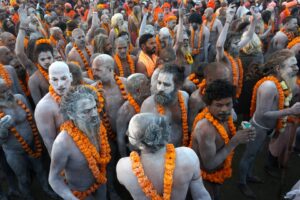India has an important religious festival, the Kumbha Mela (Gathering of the Great Jug), which takes place once every 12 years, on the day of a special arrangement of the planets. This is known to the experts who carry out https://www.julianalucky.com/yoga-for-kids.
It is a special festival of spiritual traditions and a rite of mass Hindu pilgrimage to the Shrines of Hinduism, held when Jupiter finds himself in the same position as the fall of the discharged drop of amrita according to an ancient Vedic legend, which says:

“Once upon a time, in those immemorial times, the Gods who still lived on earth lost some of their power because a curse was placed upon them that robbed them of their strength and courage. Brahma (the creator god with perfect knowledge of rituals) advised them to plow the prehistoric milky ocean of the universe in order to obtain amrita, the miraculous elixir of immortality. To accomplish this difficult task, the gods concluded a temporary truce with the asuras, the demons (or, more accurately, the titans), and enlisted the support of Vasuki, king of the snakes.
The giant Vasuki wrapped himself around the legendary axis of the universe – Mount Mandara, the demons took hold of his head, the gods by the tail, and the process began…
After 1000 earth years (only 100 years flew by for the gods) the work was finished – a lot of wonderful artifacts appeared from the thickened milk, and after them divine healer Dhavantari (this very sage transmitted knowledge, science of everyday life – Ayurveda) himself with a kumbha (jug) full of amrita. The truce, naturally, was immediately forgotten, and a battle that lasted 12 years began. Eventually the divine bird Garuda (whom Vishnu carries on his back) managed to get hold of the kumbha with amrita and flew away with it to a land far away.
To this day, water in certain places in India becomes amrita on the days of the great festival.
Every three years the cities of Prayag (Allahabad), Haridwar, Ujjain and Nashik become the pilgrims’ targets.
Ardha Kumbha Mela is held every six years in Haridwar and Allahabad, while Purna (full Kumbha Mela always takes place in Allahabad every twelve years.) Maha (great) Kumbha Mela comes after 12 Purna Kumbha Mela”, every 144 years.
The festival is primarily attended by representatives of the most diverse branches of Hinduism: sadhus – wandering ascetics, sanyasins, yogis, representatives of ashrams and Gurus of almost all traditions, and of course simply lay pilgrims.
To give you a clearer idea of the scale of the event, here’s a geographical comparison: the population spread out over several square kilometers of Mela is our Western Siberia + Eastern Siberia + the Far East.
The festivities culminate in a mass ablution in the waters of the Ganges (in Haridwar), Sipra (in Ujjain), Godavari (in Nashik) or Sangam (in Allahabad), symbolizing purification of body and soul.
Hindus believe that the “bathed” man is no longer the same as he was yesterday: he has taken one giant step towards his personal and universal spiritual evolution, which, unlike Darwin’s evolution, does not lead to the survival and domination of the strongest individuals and species, but to the prosperity and happiness of all living beings in the universe.
It is a well-known fact that Lahiri Mahasaya, the spiritual teacher of the most famous yogi Paramahamsa Yogananda (who wrote “Autobiography of a Yogi”), met his future guru – the legendary and immortal master of Kriya Yoga Mahavatar Babaji, who, according to legend, is now in a cave in the Himalayas, in a perfect state of samadhi… The gods who are invisibly present at the feast, however, are rumored to be simply enjoying the divine play of the Almighty, expressed in the form of an unimaginable accumulation of “bipeds.
Besides the favorable position of the planets, the blessing of the holy hermits (sadhus), who interrupt their severe asceses and descend from the mountains to participate in the divine game, is also considered highly desirable. On the main days of the festival, the royal snan, an unforgettable “naked parade” of sadhus takes place, with hermits dressed in the sky, covered in ashes and adorned with garlands of flowers, parading through the city shaking their ritual weapons, continually spreading around them waves of shakti, the most powerful healing energy they have accumulated over decades of yogic practice.
This photo was taken in one of India’s holy cities, Allahabad, during the celebration of the Kumbha Mela in 2001. The photo shows pilgrims waiting on pontoon bridges for their turn to take a dip in the holy place, where the Ganges merges with the Yamuna. The Indian government reported that about 70 million people came to take a bath!
